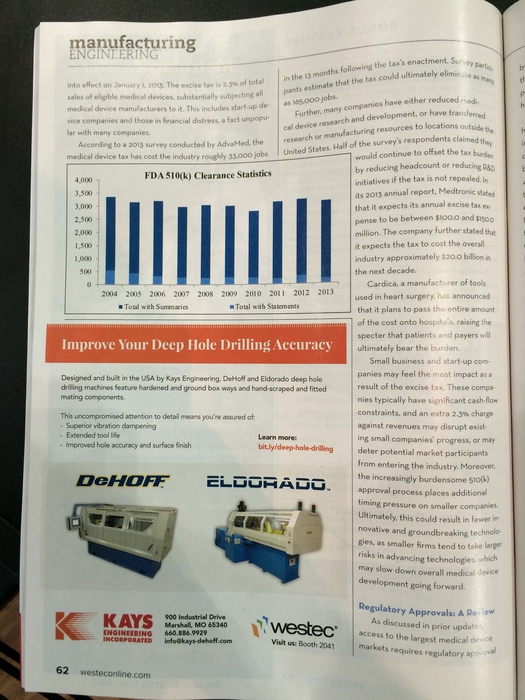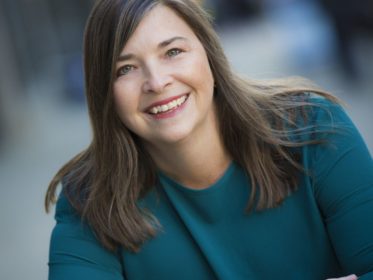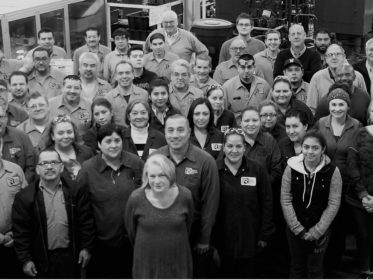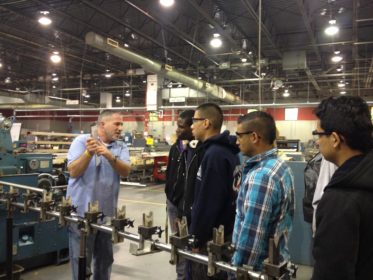According to the 2,288 manufacturing managers and engineers Gardner Business Media surveyed for their 2015 Media Usage research study, 86% ranked trade magazines as their number one and number two choice with regard to “effectiveness in terms of finding information.”

Asked what type of trade magazine content delivery they preferred, 55% of these managers and engineers said “print magazines.”

When I first wrote about Gardner’s survey data, I took the information about print magazines with a grain of salt. Gardner is in the business of producing print publications, I thought, so their survey results would tilt toward print.
Since writing that post, I’ve visited a fair number of small manufacturers. The one thing I see, no matter the size of manufacturer or job shop, is trade publications: on lobby coffee tables; in the bathroom; on the shop floor. More important, I see them on people’s desks and credenzas.
Trade publications, despite the digital revolution (or maybe because of it), are seemingly thriving, thankyouverymuch.
To see if my assumption was correct, I spoke with Rick Kline, Sr. CEO of Gardner Business Media.
Print ad trend: smaller, full-color
I specifically wanted to know if Kline had seen any trends with regard to print ads. Were advertisers running more or less? Were they using QR codes or no? Based on the publications I read, it seemed more advertisers were running smaller ads.
Kline confirmed my hunch and noted the growing use of full-color quarter, half-page, and island ad sizes. These ads get placed adjacent to editorial versus being stand-alone, the way full-page ads are. Thus, they’re more noticed by readers. And while the size is smaller, advertisers do pay a premium to run these ads in full color.
An example is the one-third page ad my client Kays Engineering ran in SME’s Manufacturing Engineering’s Westec Preview issue.

Print advertising ROI – Does it exist?
The perceived lack of ROI with regard to print advertising is what keeps more companies from advertising. Yet smaller manufacturers and job shops will spend thousands of dollars on a 10’ x 10’ tradeshow booth – which may or may not deliver ROI.
According to Kline, the more savvy advertisers use special phone numbers or URLs to track visits to a company’s website. “Many of our customers do measure traffic and get inquiries,” he said. (I covered this topic a couple of weeks ago in my post about print ad calls-to-action; link below.)
“With print advertising, you can run your ad during months when editorial is more appropriate to your products or services or you can run an ad consecutive months. You can also take advantage of special tradeshow issues. The point is, print advertising is quite economical cost-wise, when compared to a tradeshow, and gets your company name in front of thousands of people – and for months after the publication has been printed.”
“Print exposes people to things they don’t know.”
Like all publishers, Gardner has the challenge of providing its message the way its audience prefers it. Delivery can happen on a tablet, a website, a smartphone, or print. “The device is the medium,” said Kline. “Print is a medium, too, and our audience does prefer it. The medium is important but what’s more important is the content.”
According to Kline, trade publications give readers information they often don’t know about.
“Trade publications, and Gardner’s in particular, are filled with how-to information, application stories, and case studies. Our editors go out and talk to manufacturers and engineers to hear their success stories and challenges. Our editorial stresses new technologies. We want to help our readers improve their plants and be more competitive here in the U.S. and around the world.”
The difference between a print publication and a search engine, according to Kline, is that print is a “push” medium while search is a “pull” medium.
With a search engine, you don’t know what information you’re missing because unless you know about something, you don’t know what to search for. And, with the search filter bubble, you may be exposed to content which by-and-large fits your worldview — thus precluding you from learning something new that’s outside your existing perspective.
With a print publication, the information comes to you.
“Print exposes people to things they might not otherwise know or learn,” says Kline. “It’s one reason why people prefer it. For Gardner, we use the ‘push’ of print to deliver information readers will only find in the magazine.”
To ascertain readers’ needs and challenges, Gardner set up a LinkedIn Group open only to owners of small shops (no vendors or advertisers). “We simply listen to what these owners talk about,” says Kline.
It’s due to these reasons, and others, that the company has seen a 150% growth in print advertising in the last six years.
“We know our readers are older and that the younger generation is moving up the ranks,” says Kline. “We’re very aware of the technology mediums people use to find information. It’s why we’re converting our websites to responsive design. But, technology is still just a medium. What really counts is the content – and in that, we’ll continue to remain focused on providing the application notes and technology stories our readers can’t find anywhere else.”
Article citations
2015 Media Usage in Manufacturing Report, Gardner Media
Manufacturing Buyers Read Print Trade Magazines (Shocking!), Huff Industrial Marketing blog post
Creating People Friendly Calls-to-Action for Manufacturing Print Ads, Huff Industrial Marketing blog post





Cory Ploessl
Thanks for the article Dianna. As a marketing manager I look at some of these print-ad costs and I just don’t see how the ROI can happen sometimes, but this is very encouraging. The only part that is disheartening is you can only put so much ‘content’ in an ad — you really have to put faith in the magazine that they will provide your customers with pertinent and interesting information to keep them engaged.
Dianna Huff
Thanks for the reply, Cory. Writing ad copy is a whole art unto itself. It takes real skill to communicate a benefit to the reader — and do it in as few words as possible.
It also helps to read the publications you’re considering for a few months. By reading them for 3 – 4 months, you’ll get a really good sense if it’s a good publication for your needs.
BTW, Volkswagen, established its network of US Beetle dealers in 1953 and sold 2,000 vehicles w/o advertising. In 1959 the company hired DDB, the ad agency, In 1962, VW sold 200,000 vehicles in the U.S. — people would walk into the showroom quoting the latest ad. 😉
If you have time, read, Ogilvy on Advertising. Classic.
Adealingz Akhter
I am actually surprised after reading this? 55% share for print magazines. :O I believe digital mediums can give a higher ROI than placing ADs in relevant magazines. For sure in some industries that might not be the case but yet even for manufacturers and industrial companies INTERNET is a better option in every way. I have personally worked with some of the great manufacturers and ROI was much better on digital platforms.
Dianna Huff
Hi Adealingz – Thanks for the response. I’d love to see any testing / data analysis you’ve done that’s specific to manufacturers / job shops and ROI of print ads vs. digital platforms. Do you have a blog post to which you can link?
Adealingz Akhter
Hi Diana,
Honored to have you connected. Unfortunately I never tried split testing or data analysis which I can relate to ROI of print ads vs. digital platforms. But my experience so far has been the digital media is more effective in many ways.
In general how many leads a manufacturer can expect in a month after publishing an AD in a highly targeted and most relevant magazine? More over what will be the maximum geographical reach of that magazine?
How about spending USD 500 per month as a manufacturer to get 2 great benefits.
A) Getting around 10-20 business leads which follow the criteria of
1) Contact details of the company
2) Contact details of the decision maker
3) Social Media Presence OR
4) Presence on internet
5) Either Meeting the MOQ from the beginning OR can consider to buy more depending upon price negotiation or at a later stage after seeing the quality
B) Getting SEO content (2-5 articles per week of 300 to 500 words) to optimize the website.
You are more experienced than I am so I would love to know your opinion on this?
For sure when going digital the only drawback is that the consultant of manufacturing businesses wont work for a month. Instead it will be a 3,6,9 or 12 months contract but still the probability of higher ROI is HIGHER.
Let me share stats and figures from my personal experience. A manufacturer pays USD 9000 lump sum amount for an year and the same year generates sales of USD 106,000 (including re-orders). That means the manufacturers actual cost per month was USD 750. What do you say? Still the manufacturer should have gone with pint media ADS?
NOTE: not to forget the manufacturer benefited with an optimized website and even after post ponding the idea to continue with the consultant, reaped the benefits for coming years. 🙂
Rachel Cunliffe
I don’t think it’s either/or. It’s about deeply knowing your target customers and where they spend their time and what they trust. Reach isn’t important if the target customers aren’t there.
Adealingz Akhter
@cre8d:disqus
Thanks for your opinion. I do agree with you that we need to understand the customers :). How ever generating leads through digital mediums (and nurturing them) is a better option from my perspective than advertising on printed magazines.